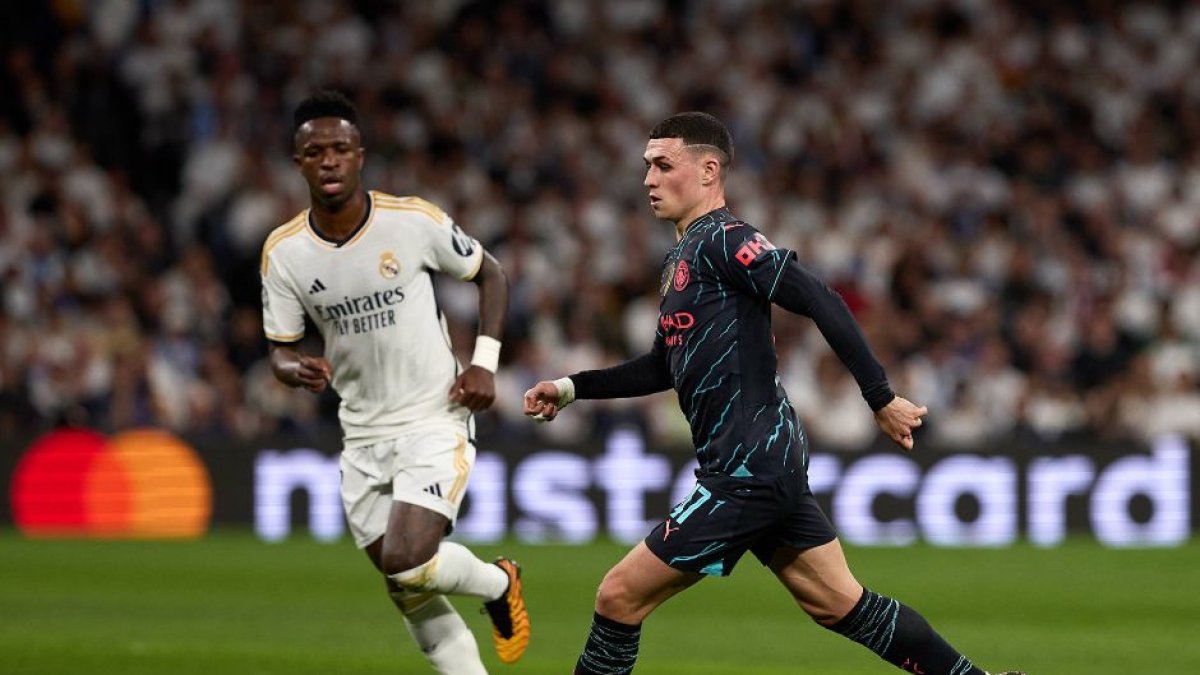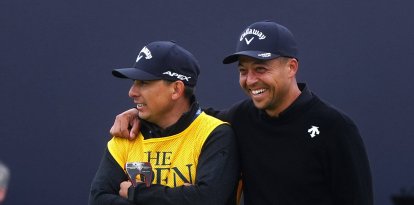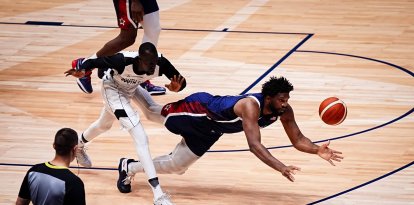Champions League: Real Madrid and Manchester City star in a spectacular 3-3 that leaves all possibilities on the table
It was a dynamic and exciting match. Both teams struck at the right time and showed overwhelming efficiency.

Vinicius Jr. y Phil Foden, grandes protagonistas del partido. (Cordon Press)
Real Madrid and Manchester City staged a tremendous tactical battle at the Santiago Bernabéu stadium, ending in a 3-3 tie. The match was full of changes and emotional development, leaving the path entirely open for the return leg at the Etihad Stadium.
Fans usually think of a tactical match as a closed game without goals, but in reality, the strategies, defensive positional order, and dispositions of the offensive teams do not necessarily mean a boring and hindered match.
Both Madrid and Manchester City knew it was a day to attack. Guardiola’s men, led by Grealish, attacked Tchouaméni’s side before the first minute of play, converted into central defense for the duel, and reaped the benefits: a warning against the French central defender who had to stop the English winger with a strong tackle below.
The Madrid side did not finish lamenting the yellow card for Tchouaméni when the Portuguese Bernardo Silva, in a moment of mischief, took advantage of the poor position of the Ukrainian Lunin to score 0-1—a bucket of cold water for Ancelotti’s men who were just warming up.
Rodry and Vini’s dance
But Real Madrid quickly took the hit, so fast that City could not take control of the game through ball possession.
With the talent of Rodrygo and Vinicius, in addition to the great defense of Rudiger and Kroos, Madrid canceled Haaland and Foden in the first half and began to dominate the development through its “disorderly” functional attacks.
Vinicius and Rodrygo were too much for City’s last line. They put together uncontrollable blocks, combinations and dribbles against Stones, Días, Akanji and Gvardiol. The game was played as the Brazilians wanted, who were impressive on the offensive side and necessary to make Rodri uncomfortable at the start and force City to play a one-on-one game, plagued by counterattacks and without long possessions.
That’s why Madrid came back into the game in a matter of minutes.
First, thanks to Camavinga, who took charge, drove to three-quarters of the field and finished off a ball that, without a providential deviation in the movement of Rubén Días, would have seen the goal line. The rebound left the German-Spanish Ortega out of control, and Ancelotti’s team tied up the ga without breaking a sweat.
Two minutes later, Rodrygo appeared, the most unbalancing and differential player of the first half. After a set by Vinicius, the former Santos player from Brazil rode the Akanji zone, getting into the City cave, feinting in the area, and finishing between the legs of the Swiss defender, who once again left Ortega without an answer for another tiny rebound.
This move once again demonstrates that Rodrygo, despite the criticism, is a world-class footballer who has a particular love affair with the Champions League.
Madrid objectively dominated that first half. They took City to the field blow by blow and allowed their two Brazilian forwards to shine. In the Manchester team, Haaland was isolated, Foden disjointed, and Grealish was well-controlled by Carvajal. The only ones who could feel comfortable in the development were Silva and Kovacic, perhaps the only ones who gave oxygen to Guardiola’s men, that something had to change if they did not want to leave with more goals in the basket.
Madrid’s step back
Although Madrid had more options to increase the score in the first half, the game changed in the second half.
Yes, Madrid had cons and clear situations at the feet of Vinicius and Bellingham with the game at 2-1, but the sensations were different.
City started to play and put Rodri, Kovacic, and Foden up front. Bernardo and Grealish anchored the Madrid fullbacks, but the English team’s centerbacks did not let the meringues turn. The control went from white to sky blue.
This is how, in a defensive oversight, City put Foden on the edge of the area, and the young English striker took a left-footed shot against Lunin’s corner at 66’ of the second half. It is, without a doubt, one of the best goals of the tournament.
Five minutes later, as if they had stolen the recipe for Madrid’s comeback, Gvardiol, the Croatian central defender with a left-footed profile who played as a left back, hooked to his right 25 meters from the rival goal and took a right kick and slipped the ball into the other corner of the Madrid goal. Two great goals for a second comeback that confirmed that City, without needing to modify pieces, changed the development of the match.
Ancelotti, who was always at the head of the class, detected that he had to sacrifice two of his figures (Kroos and Rodrygo) to make way for players with fresher legs and similar characteristics: Modric and Brahim.
The game didn’t exactly change, but it did keep City at bay, which began to allow counterattacks and clean exits from Real Madrid.
Just before entering the game’s final phase, at 79’, Madrid stood on the left with Vinicius, who passed a precise ball for Federico Valverde.
The Uruguayan, honoring his majestic punch, hit it with his right and sealed the final result of this tremendous tactical war that will have its final battle next Wednesday in England.

























